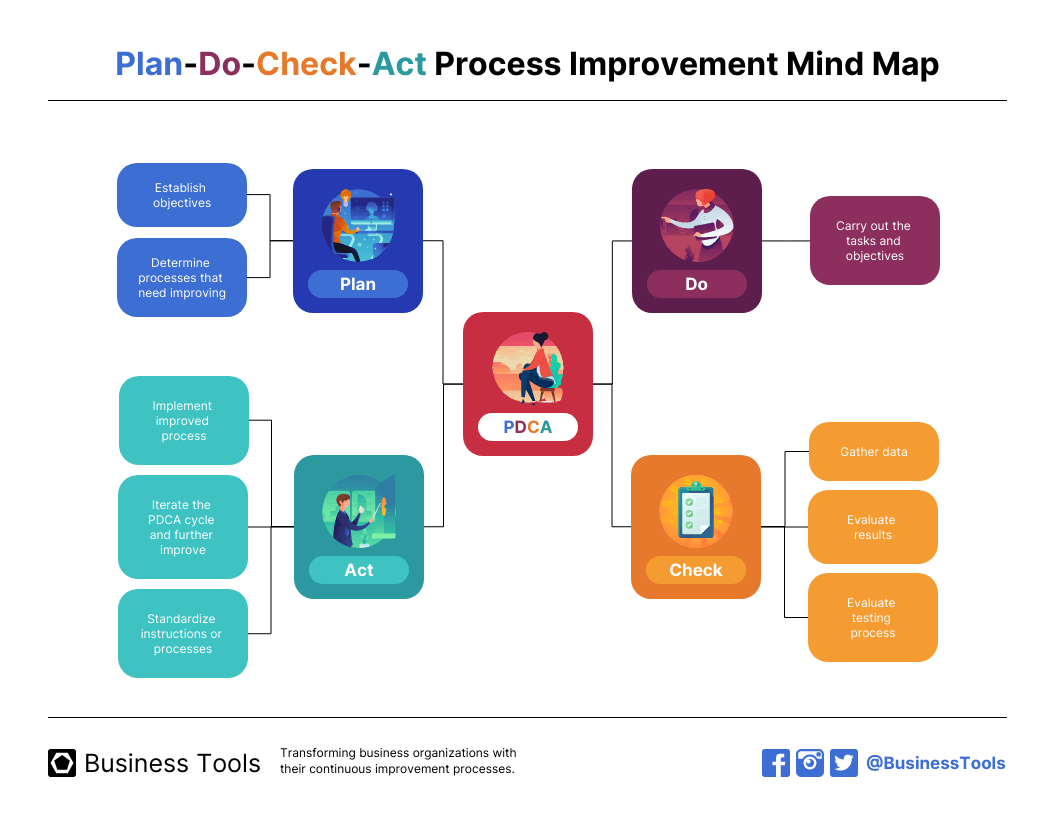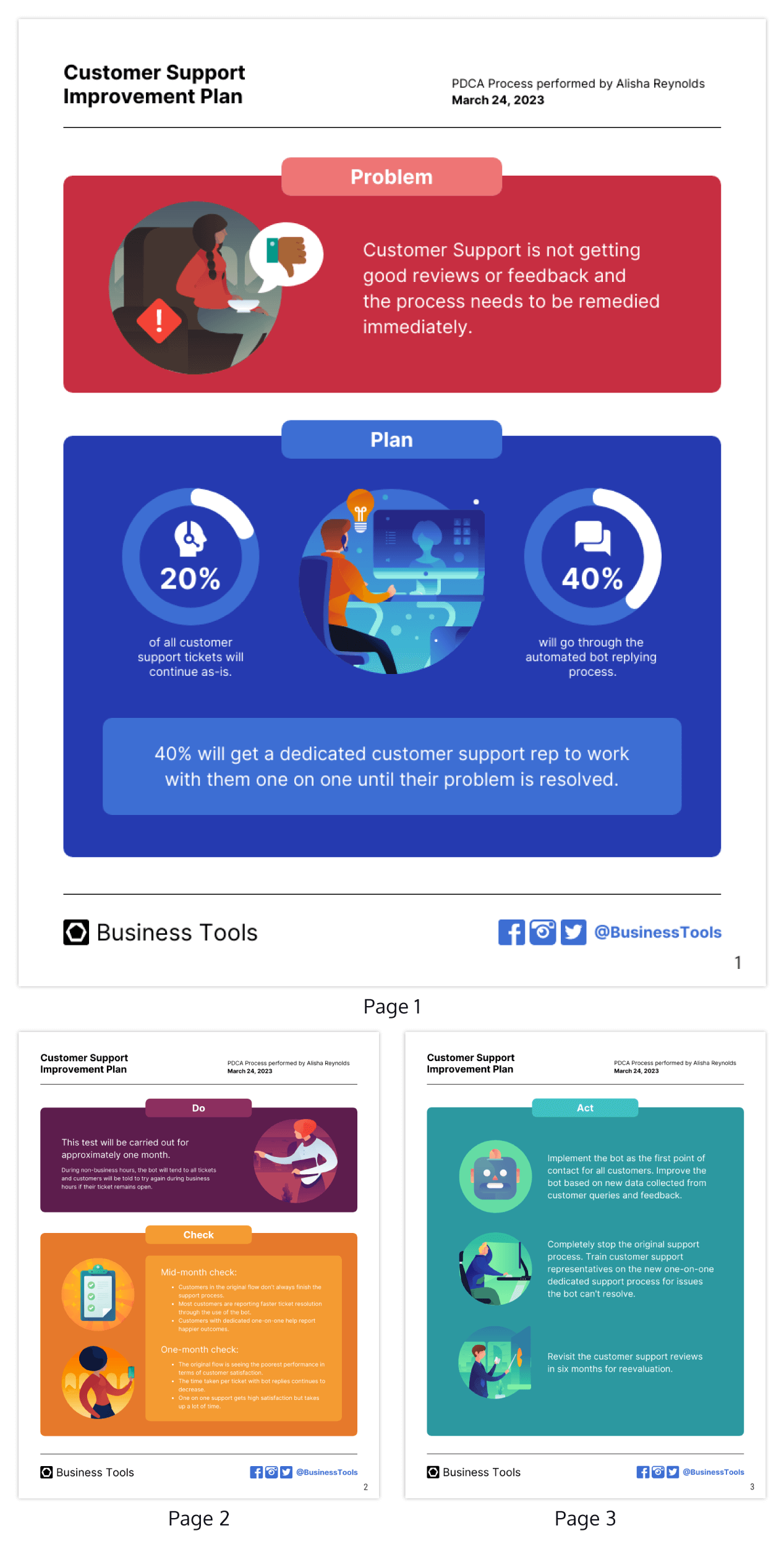
Process improvement and change management are critical but difficult tasks in any organization. But following a process improvement system can help, and many organizations rely on the PDCA cycle to help them get better.
Let’s explore the details of PDCA and review how organizations can use visual communication tools like infographics, checklists, flyers and more to help team members navigate disruption.
Learn how you can use Venngage to apply visuals to your employee training and development and process improvement materials—no design experience required.
Click to jump ahead:
- What is the PDCA cycle?
- Advantages and disadvantages of PDCA
- How do you use the PDCA cycle?
- How to use visual communication in PDCA process
What is the PDCA cycle?
Plan-Do-Check-Act, or PDCA, is a model for continuous process improvement. Engineer and management consultant W. Edwards Deming developed it in the 1950s, using the word “Study” in place of “Check,” and it came to be known as the Deming wheel or Deming cycle. Japanese engineers later modified it, bringing us to the present-day version, PDCA cycle.
The PDCA cycle is useful across a range of business needs, including new product launches, major process overhauls and whenever a new process or a change is introduced to the organization. It follows that this model is essential not just to process improvement but also process documentation.
Related: 20+ Process Documentation Templates to Guide Business Processes
Here’s a closer look at the steps:
- Plan: Identify the problem or issue you will be targeting
- Do: Formulate and test potential solutions to the problem
- Check: Examine the results of each test (and sometimes modify test parameters and re-test)
- Act: Implement the solution that best fits your needs
Implied in the name and shape of the PDCA cycle is that it is continuous. Just as a wheel keeps rolling, the PDCA cycle is designed for you to start over again, identifying any new problems that have cropped up with your process and going through every step again.
Learn more about putting standard operating procedures into place after you’ve completed your PDCA cycle.
What are the biggest advantages and disadvantages of the PDCA cycle?
The PDCA cycle change management framework is a simple way of understanding process improvement, but it may not be right for every organization. So, what are some of its biggest pros and cons?
Advantages
- Simple to understand
- Allows for testing multiple solutions
- High potential for breakthrough innovations
Disadvantages
- Time-consuming, not ideal for crises that need rapid solutions
- Requires ongoing commitment, which can increase change fatigue
- May be overly simplistic for large-scale organizational change
Relying on the PDCA cycle for large-scale organizational change requires using the framework to consider every part of your business, which means the cycle is repeated constantly. Depending on the scope of change and size of your organization, this may be unrealistic.
Related:
- Change Management Strategies to Reduce Resistance and Ease Acceptance
- How to Make an Effective Change Management Plan Using Visuals
- Effective Communication for Change Management: Infographics for Transformative Leadership
How do you use the PDCA cycle?
Getting the most out of any tool requires using it correctly, and this is true for the plan-do-check-act cycle, too. Let’s explore some potential outcomes of the PDCA cycle and PDCA examples you can use in your organization.
Customer service PDCA improvement plan
This template presents in detail how a Customer Support department can use PDCA to improve its processes. You can customize this plan for your own company’s Customer Support teams, or for just about any process improvement or change management projects that come up.
Notice the use of icons and illustrations to help visualize the information and liven up the plan at the same time. If you want to swap out any of these icons, simply double click one and choose the alternative:

Marketing PDCA cycle example
SEO and content marketing is pretty much one continuous PDCA cycle. That’s because if you are trying to drive organic traffic to your website, you have to constantly check your numbers, try new things and decide what works best.
Here’s an example of how to apply PDCA to increase website traffic:
- Plan: Fix low traffic to important content on your website
- Do: Explore new methods like email marketing, social media, ads and content marketing
- Check: Review the results of each method, identifying which ones increased traffic the most
- Act: Depending on the results, implement new methods permanently. If none were sufficient, begin the process again. And if you adopt any of the new methods, continue the PDCA cycle to optimize those methods.
Use this marketing checklist to optimize your SEO and social media content as part of your ongoing commitment to PDCA.
Related:
- How to Use Guestographics to Build Links & Increase Your SEO Rankings Fast
- How to Use Mini Infographics to Improve On-Page SEO
- 10 Content Marketing Infographics for Your Strategy
- How to Create Job Aids [With Examples and Templates]
Hiring PDCA cycle example
If your organization has a difficult time hiring the right employees, the problem could be related to your hiring and onboarding process.
Let’s take a look at how you can address a hiring problem and improve the experience of new employees through the use of PDCA:
- Plan: Examine process for interviewing, hiring and onboarding
- Do: Identify best sources of good candidates for different job types, experiment with vetting process and implement new onboarding materials.
- Check: Compare the effectiveness and success of new hires regarding each new aspect of the hiring process, revise aspects touched on in previous step if necessary
- Act: Solidify changes or revise experiment and begin again
If your company relies on hiring flyers or social media posts to alert interested parties about job openings, try some A/B testing by creating different versions of flyers to see what types of candidates are most drawn to each version.
Related:
- How to Create an Engaging Orientation & Onboarding Program for New Employees
- 14+ Editable Onboarding Checklist Templates for Businesses in 2021
- 40+ HR Infographic Templates for Talent Management
Employee training & development PDCA cycle example
The PDCA cycle and visual tools are ideal for employee development and training. And the business case for improving your employee development tools is clear: A LinkedIn survey found that 94% of workers would stay longer with a company that invested in helping them learn and get better.
Learn how you can apply the PDCA cycle to building a training program:
- Plan: Train sales department on new customer relationship management tool
- Do: Identify ideal method and timing for training the entire department and/or individual team members
- Check: Compare individual employees’ uptake of the material to determine if one training method is better than the other
- Act: If no methods provide sufficient results, begin process again; if one method is a clear winner, implement it across the team and begin PDCA cycle for using method for other types of training in the organization
While this training assessment needs checklist was created for a healthcare facility, it can be easily customized to speak to the individual competencies involved with training your sales staff on a new CRM platform.
Related:
Want to see how others visualize iterative processes like PDCA? These process infographic examples showcase creative ways to present cycles, workflows, and continuous improvement strategies.
How to use visual communication in PDCA process
While PDCA is a relatively simple framework, each step requires a unique approach in order to get the most out of the process improvement method. That’s where visual communication tools like infographics, checklists, timelines and others can come in handy.
Here’s a look at some additional ways to use visual communication in your PDCA process.
PDCA checklists
Checklists are useful throughout the PDCA process to ensure tasks are being completed, whether it’s identifying problems or testing out solutions.
Keep track of cross-departmental tasks during your PDCA process with this checklist template. Update the teams and tasks to make them appropriate for your needs.
This checklist template is ideal for organizations that will have to get their arms around many job tasks and processes as they work through the PDCA cycle. Not enough space? You can quickly and easily add pages in Venngage.
A checklist like this is ideal for helping identify hurdles and breakdowns in your existing processes, and it can be used to check-in meetings after every major step of the PDCA cycle.
PDCA timelines & schedules
One of the biggest drawbacks of using PDCA for process improvement is that it can be quite time-consuming, and given its cyclical nature, it’s hard to know when you’re done. Keep your team on track by creating timelines and schedules.
Establish major milestones at intervals that make sense for your organization. For example, revisiting our HR department’s plan to refresh their hiring process, each new hire could represent a major milestone and individual elements could apply to specific competencies they should be gaining through onboarding.
A project timeline template like this one is ideal for organizations in which the PDCA process will touch many teams or functions in the company.
Keep the team up to date on where you stand in the PDCA process by tracking and sharing major milestones with this timeline infographic.
PDCA process diagrams & flowcharts
Process diagrams and flowcharts are an excellent way to understand your current operations. In some cases, you may identify breakdowns immediately, but in any event, visualizing existing processes is critical to improving them.
This flowchart template can help you diagnose and diagram many processes in your organization, and with Venngage’s flowchart maker, it’s simple to add or take points away.
Using our earlier SEO example, this production process fishbone diagram could be updated to visualize what steps the marketing team takes to identify content topics.
A manufacturing company looking to implement PDCA could use a product decision tree like this to make a data-driven decision in the Do, Check and Act steps.
PDCA infographics
Infographics can help companies implement the PDCA model by enabling them to visualize data, compare possible solutions and more.
Use this statistical infographic template to visualize any data points generated during the Check segment of your PDCA process.
Here’s another example of how companies can use infographics to help make data-driven decisions within a PDCA framework.
Compare and contrast the relative merits of solutions when you don’t have hard numbers to inform a statistical infographic. With your team, go over the pros and cons of each proposed solution until you arrive at the best fit.
In summary: Apply visuals to your PDCA model for effective change management and process improvement
Visual assets like infographics, checklists, process diagrams, flowcharts and more are ideal companions to the PDCA process. Help your team visualize the problems, identify solutions and decide how to go forward by using Venngage’s solutions for training and development teams. It’s free to get started.
























































